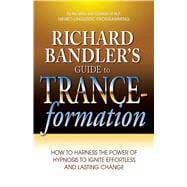
What is included with this book?
| Foreword | p. xi |
| Introduction | p. xv |
| Patterns of Process and Elicitation: How People Create Their Reality, and How We Can Know | |
| Patterns, Learning, and Change: How to Take Charge of Your Brain | p. 2 |
| Doing More of What Works: The Secret of Effortless Change | p. 7 |
| Representing "Reality": The Birth of Personal Freedom | p. 19 |
| Language and Change: The Gentle Art of Casting Spells | p. 31 |
| Directions or Outcomes: Planning to Succeed | p. 51 |
| Seeing Inside the Black Box: Accessing Cues, Predicates, and Strategies | p. 65 |
| Submodality Distinctions: The Differences That Make a Difference | p. 79 |
| The Power of Belief: Pink Poodles and the Placebo Effect | p. 93 |
| Patterns of Induction: Hypnosis and the Art of Creating Powerful Learning States | |
| Developing Your Skills: Altered States, Hypnosis, and the Power to Learn | p. 106 |
| Hypnosis and Control: Success Is an Altered State | p. 121 |
| Inside and Down: The Patterns of Trance-formations | p. 133 |
| Deeper, and Faster, Still: Rapid Induction and Trance-Deepening Techniques | p. 151 |
| Remembered Peace: Accessing Previous Trance | p. 161 |
| Creativity out of Confusion: Pattern Interrupts, Stacked Realities, and Nested Loops | p. 167 |
| Advanced Submodalities: Freedom, Fun, and Fuzzy Function | p. 179 |
| Patterns of Utilization: Using the Tools of Trance-formation | |
| Back to the Future: Changing Personal History | p. 190 |
| Pushing Past Limitations: Hesitation, Threshold, and the Freedom Beyond | p. 209 |
| Repatterning the Past: The Magic of False Memories | p. 225 |
| Trance-Formation in Action: Client Sessions | |
| The Structure of Trance-formation 1 | p. 237 |
| The Structure of Trance-formation 2 | p. 243 |
| The Process of Trance-formation 1: Fear of Needles | p. 249 |
| The Process of Trance-formation 2: Fear of Flying | p. 270 |
| A Trance to Fly By | p. 284 |
| In Conclusion | p. 293 |
| Glossary | p. 301 |
| Resource Files | p. 305 |
| Anchors and Anchoring | p. 305 |
| Sensory Predicates | p. 308 |
| Some Submodality Distinctions | p. 310 |
| The Meta Model in Brief | p. 311 |
| Milton Model Patterns | p. 316 |
| Eliciting and Annotating Strategies | p. 327 |
| Recommended Reading and Audiovisual Resources | p. 329 |
| Websites | p. 330 |
| The Society of NLP Richard Bandler Licensing Agreement | p. 331 |
| Index | p. 333 |
| Table of Contents provided by Ingram. All Rights Reserved. |
The New copy of this book will include any supplemental materials advertised. Please check the title of the book to determine if it should include any access cards, study guides, lab manuals, CDs, etc.
The Used, Rental and eBook copies of this book are not guaranteed to include any supplemental materials. Typically, only the book itself is included. This is true even if the title states it includes any access cards, study guides, lab manuals, CDs, etc.
Excerpted from Richard Bandler's Guide to Trance-Formation: How to Harness the Power of Hypnosis to Ignite Effortless and Lasting Change by Richard Bandler
All rights reserved by the original copyright owners. Excerpts are provided for display purposes only and may not be reproduced, reprinted or distributed without the written permission of the publisher.